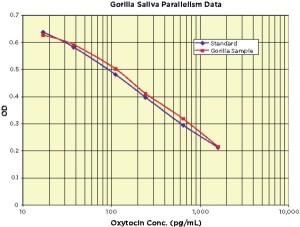The neuropeptides, Oxytocin and Vasopressin, were isolated and synthesized by Vincent du Vigneaud at Cornell Medical College in 1953, work for which he received the Nobel Prize in Chemistry in 1955. Oxytocin is a neurohypophysial peptide which is produced in the paraventricular nuclei of the hypothalamus and stored in the posterior pituitary. The molecule consists of nine amino acids linked with a disulfide bond and a semi-flexible carboxyamidated tail. Recent studies have defined Oxytocin’s role in various behaviors like social recognition, pair bonding, anxiety, and maternal behaviors (1-4) but also, male reproductive physiology. (5)
Oxytocin and the related neurohypophysial peptide, Arg8-Vasopressin, maintain renal water and sodium balance. (6)
Highly conserved across species boundaries, Oxytocin-like neurohypophysial peptides are substituted primarily at residues 4 and/or 8.  In the Oxytocin-like peptide, Mesotocin, a common peptide found in some fishes, reptiles, birds, amphibians, marsupials and nonmammaliantetrapods, the leucine at residue 8 is substituted for isoleucine. (7)
In the Oxytocin-like peptide, Mesotocin, a common peptide found in some fishes, reptiles, birds, amphibians, marsupials and nonmammaliantetrapods, the leucine at residue 8 is substituted for isoleucine. (7)
Acting in classical endocrine fashion, oxytocin elicits regulatory effects by binding to only one known specific cell surface type of receptors. This binding initiates a secondary intracelluar response cascade via a Phosphoinositide signaling pathway. A recent paper suggests that experiences of childhood emotional maltreatment may alter salivary Oxytocin levels, which in turn are related to more positive perceptions of infant stimuli with positive emotions (8).

Newly developed Oxytocin assays break the 10 pg/mL barrier, offering reproducible, reliable, affordable and consistent detection of human Oxytocin. They are designed to quantitatively measure Oxytocin present in serum, plasma, clarified milk, and tissue culture media samples. An Oxytocin standard is provided to generate a standard curve for the assays. The assay uses an antibody that also recognises Mesotocin and Isotocin. Arbor Assays, Inc., as a supporter and exclusive supplier to the International Society for Wildlife Endocrinology, has now introduced the peptides Mesotocin and Isotocin as stand-alone products to be used as a standard for those researchers studying birds, reptiles, amphibians, coelacanths and fish.
Looking for Oxytocin, Mesotocin and Isotocin asssays?
Leave a message below!
References
- G.L. Kovacs, & D.H.K. Versteeg, “Neurohypophysial Peptides and Brain Neurochemistry.” 1993, Ann. NY Acad. Sci., 689:7 309-319.
- Insel TR, Young L, and Wang Z, “Central oxytocin and reproductive behaviours.” Rev. Reprod., 1997, 2(1): 28-37.
- A. Frasch, et al., “Oxytocin: Cellular and Molecular Approaches”, 1995, NY: Plenum Press.
- M.M. McCarthy, & M. Altemus, “Central nervous system actions of oxytocin and modulation of behavior in humans. “, Mol. Med.Today, 1997, 3(6): 269-275.
- A. Argiolas, & M.R. Melis, “Oxytocin: Cellular and Molecular Approaches”, 1995, NY: Plenum Press.
- K.P. Conrad, et al., “Influence of oxytocin on renal hemodynamics and sodium excretion.”, Ann. NY Acad. Sci., 1993, 689: 346-362.
- R. Archer, & J. Chauvet, “The neurohypophysial endocrine regulatory cascade: precursors, mediators, receptors, and effectors.”, Front. Neuroendo., 1995, 16: 237-289.
- R. Bhandari et al., “Salivary oxytocin mediates the association between emotional maltreatment and responses to emotional infant faces”, Physiol. & Behavior, 2014, 131:123–128.



